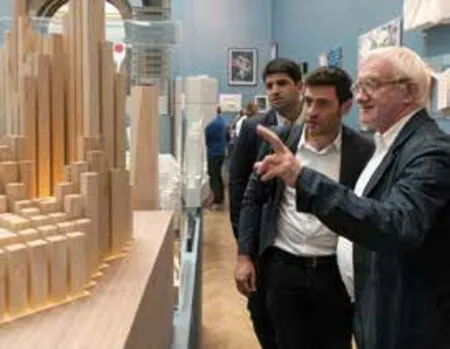专注可持续发展:福斯特建筑事务所
2021-05-11
福斯特建筑事务所是一个富有创造性的团体,团体成员来自使用70 多种不同语言的地区,事务所业务范围遍及六大洲各个时区。事务所业务涉及多种文化以及多个学科;在团队中,我们汇聚了建筑师和声学家、模型制造者和城市规划家、计算机科学家和数学家、结构和环境工程师以及工业设计师等人才。从合作伙伴到刚入职的毕业生——对卓越的追求激励着我们所有人。我们致力于共同创造丰富生活、愉悦精神的美好场所和空间。
我们的主要理念是追求探究、发现以及理解。我们相信通过讨论可以产生最佳的设计解决方案,而倾听正是这个过程的核心。每个项目都以研究未切入点,确保设计符合所在地点的气候及文化,并满足不同使用者的需求。我们的研究小组始终秉承创新原则帮助设计团队应对这些挑战。
个性化是我们处理项目的一大特征。设计通常由一组由个人组成的组织严密的小型团队负责,团队能够提供在我们这种规模的搭配中方可拥有的各项技能。项目启动后,我们的责任团队将负责项目的全流程,提供从一而终的连续性服务,这是我们一贯的原则。我们还竭尽所能平衡大型项目和小规模项目——两者的挑战不同,但回报相同。例如,我们新近完成位于美国加利福尼亚州库比蒂诺苹果公司总部大楼的建造项目,这座大楼是一个可容纳12 000 人的创新型工作场所。2016 年,我们还在英国曼彻斯特建造了一个玛吉癌症中心(Maggie's Cancer Centre),这是一所处在花园建筑中的居住房屋,也是一处庇护所,深受癌症困扰的人可以在其中找到情感支撑和实际支持。

设计实践活动由六个设计工作室进行组织。每个工作室由一位负责人领导,负责人均是在创造力、细节以及交付和管理技能方面表现出色的人员。工作室负责人均涉猎多个不同行业、地区和项目。给予这一核心群体以支持的是年轻一代的合作伙伴,他们是福斯特建筑事务所得以持续发展的核心。
自实践开始以来,我们一直就集成设计效益进行推广:理解建筑的更广泛背景,并将建筑、结构和环境设计作为一个整体。设计团队本身的特质体现出这一追求,工程师从一开始就与建筑师密切合作,相互学习,并结合自身的技能,设计出完全一体化的、可持续的设计解决方案。我们有两个内部工程团队:结构工程小组与环境工程小组。小组为设计团队和客户提供一系列的服务,范围涉及从最初的设计概念发展到全面的工程服务。结构工程师会综合多个领域的专业知识,包括高层建筑、动力及抗震设计,以及非线性和几何复杂结构等。环境工程师专门设计高效、可持续建筑系统,重点是被动技术。
这六个工作室还辅以其它多种学科,包括材料及环境研究、城市设计、产品设计、空间规划、室内设计、通讯、图形、视觉化、电影、模型制作及三维电脑造型等。我们还具备在信息技术、项目管理、合同管理和建造方面拥有专长的专家团队。
通过保持对研究的承诺——作为我们一大优势的实践——我们不仅能够跟上新发展和新技术的步伐,而且能够充分评估它们相对于单个项目的关联情况及表现情况。我们的理念在实践的基础上保持着创新探索精神。尽管我们面临的挑战日益复杂,但未来从未像现在这样激动人心。
2017 年,福斯特建筑事务所庆祝成立五十周年,映射了一个持续推动技术创新和不断提高卓越设计标准的时代。这些成就反映了对用户感受的一贯关注以及事务所的业绩表现,这些正是工作室工作的核心。工作室取得的成果就是打造出在形式和细节上经过高度打磨的建筑,这是经过持续精炼与品评的产物。
同年,通过对《巴黎协定》的研究,福斯特建筑事务所得出了令人震惊的结论:即使所有新项目都符合可持续认证的最高标准,也不足以将全球气温的平均上升趋势控制在1.5 摄氏度的目标之内。因此,当务之急必须是超越可持续建筑的当前效力。依靠技术创新和减少消费的方法不足以扭转甚至阻止所造成的损害。必须与一种持续的愿望相结合,即把建筑扎根于人们和地球的需求之中(物质需求与精神需求、有形需求与无形需求),并为健康、互连以及社交充实的生活方式而进行设计。
今天,福斯特建筑事务所致力于解决目前被视为有助于可持续性的日益广泛的问题。在这项工作中,事务所会继续从自身掌握的大量资源中获得帮助,这些资源既有内部资源也有其咨询人员和合作者网络中的资源,既有事务所对深入研究的一贯宗旨也有客户的严要求与高标准,这些对于任何项目的成功都至关重要。
我们一直是可持续设计的坚定倡导者。我们认为自己有责任努力说服客户和市政当局采取可持续的战略——在正确方向上的一小步也能有非凡的意义。我们的专业可持续发展小组直接与设计团队进行合作、提供见解、指导方向并衡量目标,以针对实践所执行的项目制定可持续发展愿景。我们的团队与来自工程、材料研究和设计学科的专家一同为我们参与的项目提供了一份可持续性发展概况。如此,设计团队从一开始就可以确定目标和方法,并对性能展开基准测试。在整个实践中,我们还拥有80 多名获LEED(美国绿色建筑评估体系)认证的建筑师和工程师。
我们的可持续设计方法包括学习当地的传统,考察当地的地形和气候,并扩展到我们面临的全球性生态和基础设施挑战。必须认识到,由城市化加快和人口增长加快所带来的复杂的社会、经济和生态挑战单靠技术手段是无法解决的;我们必须运用集成设计团队的热情和知识、客户和团体来创造可持续的解决方案。
在过去的五十年里,这一实践开发了一种定制框架,以整体的方式帮助评估从城市总体规划到私人住宅的项目。该框架基于与可持续性相关的十个主题——安居乐业、社区影响、能源和碳、流动性和连通性、资源、水、土地和生态、社会公平、变革规划和反馈,不仅超越了像LEED 和BREEAM(英国建筑研究院环境评估方法)这样的常规可持续性评估方法对环境的关注,还蕴含了社会正义和公平的理念。这些因素必须在建筑物的整个生命周期中一起进行分析和研究。
《巴黎协定》指出,地球大气温度上升2 摄氏度(最好限制在1.5 摄氏度),是避免地球上所有生命发生不可挽回变化所允许的最大升幅。如果整个世界仍“一如往常”,我们将面临4.2 摄氏度的温度升幅。在达到不可逆转的形势之前,我们有一段有限的时间: 2030 年。因此,碳减排至关重要。
人造环境的碳排放含量占大气中碳含量的近40%。经证明,250 个现有无偿绿色建筑评价体系(如LEED 或BREEAM)远远不够。如果新建筑和对现有建筑的改造符合这些评价体系规定的最高标准,全球气温仍将上升3 摄氏度,而最新指出的目标是1.5 摄氏度。
我们的研究表明,人们关注在用能源或运行能耗的同时,鲜少注意到与建筑物相关的大部分碳在制造、采购和建筑过程中被“隐藏”的现象——这被称为“隐含碳”。在过去两年中,福斯特建筑事务所与其它组织合作开发了一种方法以量化总产生的碳,包括运行能耗和实际能源产生的碳。这使得我们能够在设计方面考虑替代方案,以降低项目的碳排放含量。通过为客户提供新的福斯特建筑事务所在用建筑物售后服务方案,我们可以在建筑物的设计、建造和使用过程中持续监测具体的碳排放,以确定其最终的碳排放。即使采用最高效的低碳设计,也不可能将碳排放降至为零。因此,必须抵消残存碳。我们需要通过不同的系统进行抵消,例如利用可再生能源产生更多能源或增加重新造林面积以吸收更多的碳。
设计作为积极环境变化催化剂的潜力从未如此强大。我们今天的许多工程远远超出了建筑的传统应用。我们现在处理的项目涵盖了从个人建筑规模到主要的交通和能源基础设施,再到家具和门把手的细节。我们已经到了要把建筑环境作为一个整体来考虑的阶段——采用一种真正整体全面的方法来进行设计。我们竭尽全力对地球所做的保护尤为重要,因为地球环境是我们设计方法的核心。
气候变化是我们所有人面临的最关键挑战之一。可持续性不是时尚的问题,而是关乎生存,影响到每一个级别的建筑,无论是机场还是小公寓;可持续性要求我们从全局着眼进行思考。建筑物的位置和功能、灵活性和寿命、朝向和材料、形式和结构以及供暖和通风系统都影响到建造、运行和维护建筑物所需的能源,并影响往返建筑物的过程。建筑师无法解决世界上所有的生态问题,但是我们可以通过设计使建筑物仅以当前能源水平的一部分进行运行;我们可以推广利用能源而不是无休止地消耗能源的解决办法;我们可以通过城市规划和基础设施来改变运输模式。我们相信我们能够做到这一点,而且我们能够在改善所有人生活质量的同时做到这一点。

© Nigel Young / Foster + Partners

© Nigel Young / Foster + Partners

© Nigel Young / Foster + Partners

© Nigel Young / Foster + Partners

© Nigel Young / Foster + Partners

© Nigel Young / Foster + Partners

© Nigel Young / Foster + Partners

© Nigel Young / Foster + Partners
The Foster + Partners studio is a creative community that speaks over seventy different languages and works across six continents in virtually every time zone. We are multicultural and multidisciplinary; in a single team we might have architects and acousticians, model makers and urbanists, computer scientists and mathematicians,structural and environmental engineers and industrial designers. It is the pursuit of excellence that motivates us all, from the partners to the recently arrived graduates.Our common aim is the creation of timeless places and spaces that enrich people’s lives and lift their spirits.
Central to our ethos is an appetite for enquiry, discovery and understanding. We believe that the best design solutions are achieved through discussion - listening is at the heart of this process. Every project begins with research to ensure that the design will suit the climate and culture of its location as well as meeting the needs of its many different users. Our research groups help design teams to answer these challenges in the spirit of innovation.
The way that we approach a project is highly personalised. Design is typically undertaken by a small, close-knit team of individuals, yet this team is able to draw on the wide range of skills that only a practice of our size can offer. As a matter of principle, we ensure that the team that starts a project sees it through to completion,thus providing continuity throughout. We also deliberately balance large projects with those of a more modest scale - the challenges of both are different, but equally rewarding. Recently, for example, we completed Apple Park in Cupertino, California,USA, an innovative workplace for 12,000 people. In 2016, we also built a Maggie’s Cancer Centre in Manchester, England, a domestic-scaled building in a garden setting and a place of refuge where people affected by cancer can find emotional and practical support.
The practice is organised into six design studios. Each is led by a head of studio,who has been chosen for their proven track record in combining creativity and attention to detail with delivery and management skills. The studio heads combine a broad understanding of a number of different sectors, regions and projects. Allied with this core group is a younger generation of partners, who are central to the continuing evolution of Foster + Partners.
Since the practice’s inception, we have promoted the benefits of integrated design:understanding the wider context of a building and treating architectural, structural and environmental design as one. The nature of the design teams themselves reflects this quest, with engineers working closely with architects from the outset,learning from one another and combining their skills to devise fully integrated,sustainable design solutions. We have two in-house engineering teams: a structural engineering group, and an environmental engineering group. These groups offer a range of services for both the design teams and our clients, from the development of initial design concepts through to a full engineering service. The structural engineers combine expertise in a variety of fields, embracing tall buildings, dynamic and seismic design, as well as non-linear and geometrically complex structures. Our environmental engineers specialise in the design of efficient, sustainable building systems, with an emphasis on passive techniques.
The six studios are complemented by a wide variety of other disciplines, including material and environmental research, urban design, product design, space planning,interior design,communications, graphics, visualisation, film, model making, and threedimensional computer modelling. We also have specialist teams with expertise in information technology, project management, contract management and construction.
By maintaining a commitment to research - one of our great strengths as a practice- we are not only up to date with new developments and techniques but can also thoroughly evaluate their relevance and performance for individual projects. Our philosophy maintains the spirit of creative endeavour on which the practice was founded. Although the challenges we face are becoming more complex, the future has never been more exciting.
In 2017, Foster + Partners celebrated its fifth decade, reflecting on an era that saw a continued drive for technical innovation and ever-improving standards of design excellence. These achievements mirrored a consistent concern for the sensibilities of the user that, as well as performance, are central to the studio’s work. The result is an architecture always highly resolved in form and detail, the product of constant distillation and discriminating judgement.
In the same year, Foster + Partners’ research into the Paris Agreement came to some chastening conclusions: even if all new projects meet the highest standards of sustainable accreditations, it will not be enough to restrict the average rise of global temperatures to the 1.5-degree-Celsius target. The imperative must therefore be to go beyond the current effectiveness of sustainable architecture. Relying on technical innovations and a consumption-reduction approach is not going to be enough to reverse or even stall the damage done. It must be combined with an ongoing desire to root architecture in the needs of people and the planet - material and spiritual,measurable and intangible - and to design for a healthy, connected and socially fulfilling lifestyle.
Today, Foster + Partners is committed to confronting the ever-wider range of issues now seen as contributing to sustainability. In this effort, it will continue to be aided by the extraordinary array of resources it can command, both in-house and in its network of consultants and collaborators, by its ongoing commitment to intense research and by the demanding and discriminating nature of clients, so central to the success of any project.
We have always been committed advocates for sustainable design. We believe that we have a responsibility to try to persuade clients and civic authorities to adopt sustainable strategies - even small steps in the right direction can prove significant.Our specialist Sustainability Group, working directly with the design teams, delivers insight, informs direction and measures targets to develop a sustainable vision for projects carried out by the practice. This team, together with experts from a range of engineering, materials research and design disciplines, produces a sustainability profile for our projects. This allows design teams to determine targets and methods from the outset, and to benchmark performance. Across the practice, we also have over eighty LEED-accredited architects and engineers.
Our approach to sustainable design includes learning from vernacular traditions and examining the local topography and climate and extends to addressing the ecological and infrastructure challenges facing us globally. It is important to recognise that the complex social, economic and ecological challenges posed by rapid urbanisation and population growth cannot be solved by technological means alone; it is vital that we harness the skills, enthusiasm and knowledge of integrated design teams, clients and communities to create sustainable solutions.
Over the past fifty years, the practice has developed a bespoke framework that helps evaluate projects, from urban masterplans to private homes, in a holistic manner. Based on ten sustainability related themes - wellbeing, community impact,energy and carbon, mobility and connectivity, resources, water, land and ecology,social equity, planning for change and feedback - the framework goes beyond the environmental focus of commonly used sustainability assessment methods, such as LEED and BREEAM, by also including ideas of social justice and equity. These must be analysed together and studied over the whole life cycle of the building.
The Paris Agreement states that a two-degree-Celsius, or preferably 1.5-degree-Celsius, increase in the planet’s atmospheric temperature is the maximum increase permissible to avoid irrevocable change to all life on Earth. If the whole world remains ‘business as usual,’ we are heading for a 4.2-degree-Celsius increase.We have a limited period before we reach an irreversible position: 2030. Therefore,carbon reduction is critical.
The built environment accounts for nearly 40 per cent of carbon in the atmosphere.All 250 current voluntary green building rating systems, such as LEED or BREEAM,are proving inadequate. If new buildings and modifications to existing buildings complied to the highest standards that these rating systems propose, the global temperature would still rise by three degrees Celsius, compared to the most recent target of 1.5 degrees Celsius.
Our research has revealed that by focusing on in-use, or operational energy, less attention is given to the fact that a significant portion of the carbon associated with buildings is ‘hidden’ in the manufacturing, procurement and construction processes- this is called embodied carbon. Over the last two years, Foster + Partners, in collaboration with other organisations, has developed a methodology to quantify how much total carbon is produced, including that produced by both operational and embodied energy. This enables us to consider alternatives in terms of design to reduce the carbon content of our projects. By offering our clients a new Foster+ Partners aftercare programme for buildings in use, we can continuously monitor embodied carbon emissions throughout the design, construction and occupation of buildings, in order to determine their final carbon production. Even with the most efficient low-carbon design, it is impossible to reduce the carbon to zero. The residual carbon therefore must be offset. It must be compensated for with different systems, such as generating more energy using renewable sources or increasing reforestation to absorb more carbon.
The potential for design to be a catalyst for positive environmental change has never been greater. Much of our work today goes far beyond the way that architecture has been practised traditionally. We are now addressing projects that encompass everything from the scale of the individual building to major transport and energy infrastructure and then back down to the details of furniture and door handles. We are at the point where it is possible to consider the built environment as a totality -to apply a truly holistic approach to design. This is particularly important when every effort has to be made to protect the Earth’s environment, which is central to our design approach.
Climate change is one of the most crucial challenges facing all of us. Sustainability is not a matter of fashion but of survival, affecting architecture at every level, be it an airport or a small apartment; sustainability requires us to think holistically. A building’s location and function, flexibility and life-span, orientation and materials, form and structure and heating and ventilation systems all impact upon the amount of energy required to build, run and maintain it, and the travel to and from it. Architects cannot solve all the world’s ecological problems, but we can design buildings to run at a fraction of current energy levels; we can promote solutions that harvest energy rather than endlessly consume it; and we can influence transport patterns through urban planning and infrastructure. We believe we can do this, and we can do it while at the same time improving the quality of life for all.

© Nigel Young / Foster + Partners

© Nigel Young / Foster + Partners
